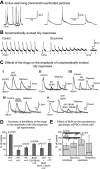Serotoninergic modulation of chloride homeostasis during maturation of the locomotor network in zebrafish
- PMID: 16291933
- PMCID: PMC6725851
- DOI: 10.1523/JNEUROSCI.2017-05.2005
Serotoninergic modulation of chloride homeostasis during maturation of the locomotor network in zebrafish
Abstract
During development, neural networks progress through important functional changes such as the generation of spontaneous activity, the expression of a depolarizing chloride gradient, and the appearance of neuromodulation. Little is known about how these processes are integrated to yield mature behaviors. We showed previously that, during the maturation of the locomotor network of the zebrafish, endogenous serotonin (5HT) increased motor activity by reducing intervals of inactivity, without affecting the active swim periods that are the target of 5HT in other and more mature preparations. Because membrane properties were constant during the rest intervals, we examined here whether 5HT modulates chloride homeostasis. We compared the effects of blocking (inward) chloride cotransport with bumetanide to the effects of 5HT and its antagonists, both behaviorally by video imaging and cellularly by whole-cell and gramicidin-perforated patch recordings. Bumetanide mimicked the effects of 5HT antagonists, by prolonging rest intervals without affecting the properties of swim episodes (duration; frequency; extent of depolarization) either behaviorally or during fictive swimming. Furthermore, bumetanide and 5HT antagonists suppressed the amplitude of depolarizing responses evoked by ionophoresis of glycine onto spinal neurons in the presence of tetrodotoxin and transiently suppressed the amplitude of responses to glycine measured after fictive swimming. The effects of bumetanide contrasted with and occluded the effects of 5HT. We suggest that, during development, endogenous 5HT modulates chloride homeostasis during the quiescent intervals and thereby offsets the long periods of quiescence commonly observed in developing networks to allow expression of sustained and behaviorally relevant activity.
Figures




References
-
- Ali DW, Drapeau P, Legendre P (2000) Development of spontaneous glycinergic currents in the Mauthner neuron of the zebrafish embryo. J Neurophysiol 84: 1726-1736. - PubMed
-
- Ben-Ari Y (2001) Developing networks play a similar melody. Trends Neurosci 24: 353-360. - PubMed
-
- Branchereau P, Morin D, Bonnot A, Ballion B, Chapron J, Viala D (2000) Development of lumbar rhythmic networks: from embryonic to neonate locomotor-like patterns in the mouse. Brain Res Bull 53: 711-718. - PubMed
-
- Brustein E, Marandi N, Kovalchuk Y, Drapeau P, Konnerth A (2003a) “In vivo” monitoring of neuronal network activity in zebrafish by two-photon Ca2+ imaging. Pflügers Arch 446: 766-773. - PubMed
-
- Brustein E, Chong M, Holmqvist B, Drapeau P (2003b) Serotonin patterns locomotor network activity in the developing zebrafish by modulating quiescent periods. J Neurobiol 57: 303-322. - PubMed
Publication types
MeSH terms
Substances
LinkOut - more resources
Full Text Sources
